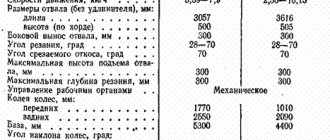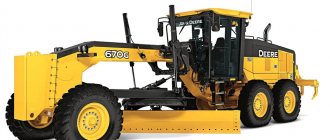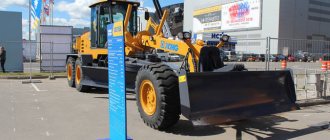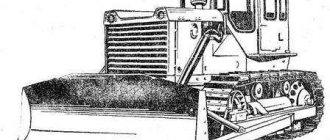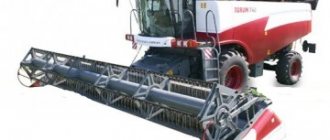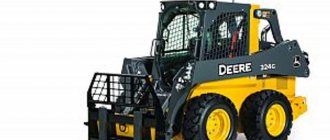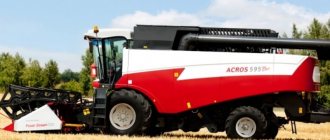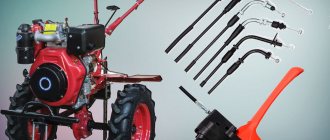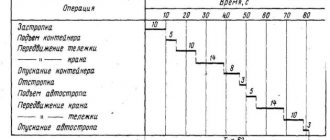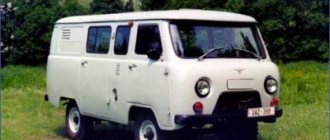In Russia, plows and harrows, hand and horse-drawn shovels, irons and rollers have long been used to build dirt roads. Initially, experiments in the construction of dirt roads using graders, carried out in the south of Russia, were not particularly successful. On black soil, dirt roads built in this way under the influence of excess moisture, especially in the spring and autumn, became wet and swollen. The first successful use of graders (plows) in our country was carried out in September 1913 on the construction of the Mostishchenskaya road near Kiev.
Trailed grader DZ-6 ( Goeyder-terrasnik D-241) (1950)
In the spring of 1914, on the initiative of the director of the Department of State Land Property P.P. Zubovsky 30 versts from St. Petersburg at the Antropshino station of the Moscow-Vindavo-Rybinsk Railway in the presence of State Councilor A.V. Krivoshein tested road vehicles imported from America, including graders. In 2 hours, a perfect dirt road 170 m long was built through a field dug with ditches, connecting the station with the nearby stationery factory of the Partnership of the Heirs of K.P. Pechatkina. The same set of road machines in the fall of 1914 during the First World War was used for 2.5 months to build 30 miles of dirt roads for military purposes. The constructed dirt roads perfectly withstood heavy rains and fully satisfied their purpose, ensuring the movement of horse-drawn and automobile transport, including heavy loaded ones.
In the spring of 1914, on the initiative of the director of the Department of State Land Property P.P. Zubovsky 30 versts from St. Petersburg at the Antropshino station of the Moscow-Vindavo-Rybinsk Railway in the presence of State Councilor A.V. Krivoshein tested road vehicles imported from America, including graders. In 2 hours, a perfect dirt road 170 m long was built through a field dug with ditches, connecting the station with the nearby stationery factory of the Partnership of the Heirs of K.P. Pechatkina. The same set of road machines in the fall of 1914 during the First World War was used for 2.5 months to build 30 miles of dirt roads for military purposes. The constructed dirt roads perfectly withstood heavy rains and fully satisfied their purpose, ensuring the movement of horse-drawn and automobile transport, including heavy loaded ones.
Grader "Patrol" (1929)
The first experiments in the construction of dirt roads in the USSR using imported American vehicles were carried out in 1926. From 1926-1927. Single production of Soviet road vehicles began to be established at the Onega plant (Petrozavodsk). In 1929-1930 The Onega plant has mastered the production of a light grader "Patrol" and a medium grader "Badger" similar to the company's American graders, with their ends on the rear axle and the front ends on the front axle. A traction frame was installed on this frame, on which a turntable with a blade and a knife was attached. The graders had mechanisms for: lifting the blade, moving the blade to the side, rotating the blade around a vertical axis, tilting the front and rear wheels, extending the rear axle to the side and turning the drawbar. In addition, the graders were equipped with blade extensions for working on light soils, as well as slopes designed for grading the outer side of the ditch. These graders were the main ones in the construction of the roadbed and were used in conjunction with a tractor with a power of 50.75 hp. With.
Grader A-12 (1931)
To ensure a two-shift, 10-hour work schedule, in 1930 in the Omsk region, the Zernotrest machine-road detachment conducted an experiment in working at night. Adams-12 grader with 60 hp Caterpillar tractor. With. processed the transverse profile of the roadway using a 12-pass scheme. For lighting, headlights from a Caterpillar tractor and a battery from a Ford car were used. The tractor driver, using the light of the headlight on the tractor, which illuminated 3-4 stakes of the stakeout, drove the tractor one and a half meters from the stakeout line. The headlights on the grader illuminated 3-4 pegs (about 60 m), which completely satisfied the grader driver.
In 1933, the production of graders decreased significantly due to the fact that the Onega plant was reoriented to the production of other products. But already in 1934, the production of light graders DGL-6 (in 1937 replaced by the grader DGL-7) was established at the Kremenchug Road Machinery Plant named after. I.V. Stalin, and medium A-8 and heavy A-12, similar to those produced by the Onega plant, similar to Adams graders, at Nikolaevsky and, in addition, the A-12 grader was produced by the road machine plant of the Sverdlovsk Oshosdor UNKVD (Istok station).
A light grader DGL-6, equipped with a blade 1840 mm (6') long, was towed by an SHTZ-15/30 tractor. The knife could be raised to a height of up to 280 mm. The wheelbase of the grader was 2550 mm, the diameter of the front wheels was 610 mm, the rear wheels were 880 mm. The front wheel track is 1270 mm, the rear wheel track is 1670 mm. The length of the grader weighing 650 kg with drawbar reached 6.6 m.
Grader DGL-7 (1937)
The light-type grader DGL-7 with a blade length of 2140 mm (7') differed from the grader DGL-6 in the presence of a mechanism for turning the drawbar, which allows you to change the direction of movement of the grader regardless of the tractor, and a mechanism for moving the blade to the side. The maximum extension of the knife was 300 mm. The DGL-7 grader did not have a mechanism for tilting the front and rear wheels, as well as additional equipment (extension for the main knife and slope).
Motor grader TsDORMASHNII (1934)
In 1934, the first prototype of a domestic motor grader was built at TsDORMASHNII, which had a wheel-tracked drive and was built on the basis of the SKHTZ-15/30 wheeled tractor, equipped with a tracked bogie of the VIME design. The grader equipment was mounted to the tractor and could be separated from it to use the tractor for another purpose. The front wheels from the SHTZ-15/30 tractor were mounted on axle shafts and equipped with devices that allowed them to tilt and rotate. The length of the knife was 3000 mm, height 495 mm. A pickaxe was installed in front of the knife. The weight of the motor grader together with the tractor reached 8 tons.
In 1936, the Nikolaev plant switched to the production of medium GS and heavy GT graders similar to Caterpillar graders. The graders were of a similar design and differed only in size. The graders had devices for tilting the front and rear wheels, devices for lateral displacement of the frame along the rear axle, a mechanism for changing the direction of movement when towing on a flexible hitch, mechanisms for lifting and lowering, turning and moving the knife to the side. The cutting angle was adjusted manually. Additionally, the grader was equipped with two knife extensions (left and right) and a slope for processing the outer slope of the ditches. The GT grader was also produced by the Sverdlovsk plant of the NKVD Gushosdor.
Grader GT (1936)
In 1937, the Nikolaev plant mastered the production of modernized heavy graders GTM model D-20. On the modernized grader, the design of the knife locking mechanism was changed with the ability to control the latch from the grader operator's seat. All mechanisms, except for moving the frame to the side and changing the cutting angle, were controlled from the grader operator’s workplace. Thanks to the special design of the traction frame and its lifting mechanism, the grader blade could be placed completely on the side of the grader and installed at an angle of up to 75° to the ground surface.
Grader GTM mod. D-20 (1937)
In the same year, the Nikolaev plant mastered the serial production of heavy graders GG model D-57 with hydraulic control. Hydraulic cylinders ensured changing the angle of inclination of the front and rear wheels, turning the drawbar, raising and lowering and skewing the knife, and rotating the turntable (rotating the knife in plan). Changing the cutting angle, as before, was done manually. The hydraulic cylinders were driven by a 6 hp internal combustion engine. With. and a gear pump with a capacity of 85 l/min (working pressure 8 MPa (80 atm.), installed on the main frame of the grader. The working bodies were controlled from the grader’s seat by a hydraulic distributor with 8 control handles and a locking bolt lever that fixes the position of the turntable on the traction frame.
Goeyder GG mod. D-57 (1937)
After the war, the Bryansk Road Machinery Plant (plant No. 790 Glavdormash) mastered the production of the pre-war heavy grader model D-20. In 1948, the plant switched to producing a reinforced grader model D-20A, designed for a tractive force of 88 kN, instead of 43 kN for the D-20 grader. On the D-20A grader, the mechanisms of the front wheels and the rotation of the turntable were controlled using one steering wheel, for which a special transmission box with a gear shift mechanism was provided. The steering wheel of the drawbar control mechanism was also mounted on the same box, the shaft of which passed through the hollow drive shaft of the handle. Since May 1951, the D-20B grader was produced, which was equipped with interchangeable metal or pneumatic wheels. The D-20B grader was equipped with indicators for setting grip angles and cutting angles.
Grader D-20A (1948)
At the end of the 40s. At the Bryansk plant, two more models of trailed graders were developed: the reinforced D-165 and the medium-class D-241.
Grader D-165 (1949)
The D-165 grader differed from the D-20A grader with the same blade length of 3660 mm by a larger base, a higher blade height, a larger blade offset to the side and a higher height, as well as the installation of a picker with a corresponding control mechanism. The D-165A grader with mechanized control was distinguished by the presence of an L-6 internal combustion engine with a power of 6 liters. With. and a mechanical drive of all control mechanisms, with the exception of the mechanism for moving the frame along the rear axle, the presence of brakes acting on the rear wheels, and electric lighting devices. The mechanisms were controlled from a special remote control at the grader operator's place.
Goeyder-terrace D-241 (1950)
The middle class grader D-241 differed from the grader D-20A in its smaller dimensions, shorter blade length (3000 mm instead of 3660 mm), the absence of mechanisms for tilting the front wheels and for moving the frame along the rear axle, as well as the possibility of dismantling the front axle and installing the front part grader frame to the coupling device of the SHTZ-NATI tractor. The latter made it possible to use the grader for constructing terraces on slopes and in mountainous areas.
Trailed grader DZ -6 70s ( Formerly called Middle Class Grader D-241)
The DZ-6 grader seems very archaic in appearance, and this is not surprising - this machine has been produced since the 1950s (at that time it was also called D-241, according to the old indexing system for road equipment), and it is based on a pre-war design. There is a plaque on the frame, from which you can find out that this grader was produced in the Ukrainian city of Korosten. The year of release, alas, is unreadable, all we know is that it is the 1970s.
Trailed grader SD-105A
The SD-105A trailed grader is designed to perform leveling, profiling and other earthworks during the construction, repair and maintenance of road surfaces, roadsides, and preparation of sites and fields for agricultural purposes.
The grader is made according to a semi-trailer design with a balancing trolley. The base tractor for the SD-105A semi-trailer grader can be the T-150K, K-700, K-701, DT-75, MTZ-1221 tractor, as well as foreign equipment from the brands JCB, John Deere, CASE, Caterpillar, New Holland and any others with towing class 2 or more, equipped with a standard 3-point hitch. Coupling with the tractor is carried out using a 3-point rear linkage of the tractor. Thanks to this, high mobility of the semi-trailer grader is achieved. The SD-105A trailed grader is controlled by the operator from the cabin of the base tractor using a hydraulic system connected to the hydraulic drive of the base tractor.
The main consumers of this grader are agricultural firms and agricultural holdings, livestock farms, forestry, road repair and construction departments. The use of trailer graders is effective in many types of work where the use of self-propelled graders is impractical from both practical (scope of work, maintenance, storage of a piece of equipment) and economic (high cost of acquisition and ownership) points of view.
Purpose and device
Like self-propelled, trailed graders, they construct the subgrade of roads and railways, and use the units in the construction of social facilities and the preparation of agricultural fields.
- clear and prepare soil areas;
- plan roadsides, slopes of embankments, excavations, construction sites;
- erect embankments of small height;
- profile unpaved and crushed stone roads;
- level, move soils, bulk materials, create building mixtures from them at the site of construction of embankments and road pavements;
- arrange ditches of small (up to 0.8 m) depth;
- They remove snow, ice crust from roads, and construction waste from sites.
A trailed grader has a main frame that rests on a rear fixed and front rotating axle, equipped with wheels (rigid, pneumatic). The front axle has a drawbar that is attached to the tractor's towbar. The frame houses a circular rotating mechanism with a blade. The latter, with the help of special devices, can be lowered/raised, moved to the side, and changed the angle of inclination.
Chassis
Wheel formula - each axle is driven, the front one is controlled.
Bevel main gear without differential mechanisms. Single-stage helical final drives. The onboard gear units of the second and third axles are equipped with a pneumatically controlled disc brake mechanism.
For braking, the friction of cermet discs placed in a crankcase with oil is used.
The balancing mechanism of the suspension of the 2nd and 3rd axles uses steel rods that synchronize the load between the frame and the chassis (reactive rods) when moving. The first bridge is hinged, the 2nd and 3rd bridges are interchangeable.
Models and their prices
The most popular among builders and road operators are semi-trailer graders SD-105 A and DZ-168. They are intended for areas characterized by a temperate climate. Unlike motor graders, they have a lower speed of movement, which is 20 km/h on a flat area, mobility, but they are distinguished by greater cross-country ability.
The trailed grader DZ-168 is produced in Bryansk. It is equipped with a hydraulic control located in the tractor cabin. The latter is used T-150K or another tractor with a traction force of 30-40 kN.
- dimensions - 6.03x2.4x2.4 m;
- dump dimensions: length - 3.74 m, height - 0.62 m;
- the distance of the blade to the side is 0.8 m;
- cutting angle with a soil dump - 30-70°;
- ground clearance - 0.35 m;
- the blade can be maximally buried in the ground by 0.25 m and rotated 360°;
- weight - 3.35 tons.
The SD-105A trailed grader is the brainchild of an experimental plant from Volgodonsk. Suitable for profiling elements of dirt roads and agricultural fields. It is controlled hydraulically by the tractor driver. Used in conjunction with tracked and wheeled tractors (T-150K, DT-75, K-701). The blade of the machine can be installed at an angle to the surface of the developed soil (building material) - 28-60.
- designed for traction force - 100 kN;
- weighs - 3.37 tons;
- with dimensions - 6.2x2.5x2.2 m;
- with welded base frame, side blade mechanism;
- with a blade immersion depth of 0.3 m, the possibility of its removal to the side by 0.7;
- length and height of the blade - 3.66 and 0.64 m, respectively;
- with blade rotation 260°;
- with clearance - 0.30 m;
- is distinguished by comfort and reliability;
- has high mobility;
- can be additionally equipped with: balancer; additional wheels; ripper-picker.
Prices for new trailed graders start from 803 thousand rubles. Used units can be found for 132 thousand rubles.
Motor grader DZ-180
Technical characteristics of DZ-180
| Overall dimensions of motor grader DZ-180 | |
| Length, mm | 8600 |
| Width, mm | 2540 |
| Height, mm | 3550 |
| Wheelbase, mm | 6200 |
| Track, mm | 2000 |
| Blade base, mm | 2570 |
| Weight parameters and loads of motor grader DZ-180 (GS-14.02) | |
| Gross weight kg | 13700 |
| Gross weight of the basic configuration with dozer blade kg | 14527 |
| Gross weight of the basic configuration with dozer blade and rear ripper kg | 15512 |
| Front wheel load kg | 9600 |
| Rear wheel load kg | 9600 |
| Grader filling tanks | |
| Fuel tank | 490 |
| Transmission. | 38 |
| Main gear. | 30 |
| Balancers (each) | 22 |
| Working equipment hydraulic system tank | 50 |
| Engine cooling system | 50 |
| Engine lubrication system | 34 |
| Blade operating parameters | |
| Departure from the track, straight frame, mm | left - 1920, right - 2020 |
| Departure from the track, frame bent, mm | left - 2556, right - 2762 |
| Blade lateral shift, mm | 700 |
| Lateral shift of the turntable, mm | left - 660, right - 760 |
| Maximum slope profiling angle, ° | 90 |
| Blade ground clearance, mm | 400 |
| Blade cutting depth, mm | 730 |
| Knife cutting angle, ° | 30 — 70 |
| Maximum traction force on the knife, kg | 8500 |
| Pressure on the knife, cutting force, kg | 7400 |
| Hydraulics of motor grader DZ-180 | |
| Maximum pressure, bar | 160 |
| Productivity at 2100 rpm of pump, l/min | 60 |
| Filters - pressure and drain with filtration fineness, microns |
One of the most popular models of motor graders in the domestic mechanical engineering industry began to be produced in 1991 by one of the oldest engineering enterprises in the country, Bryansk Arsenal - the middle class grader DZ-180. This model was created by designers based on the DZ-143. The motor grader weighs 12.5 tons. The machine can reach speeds of up to 42 km/h. Its dimensions are 8950 mm in length, 2500 mm in width, and 3510 mm in height. The turning radius is 12 m. The diesel engine power is 130 hp.
DZ-180 without the use of additional equipment can work on denser soils up to the third category, in extreme temperature conditions - from -40°C to +40°C. The special vehicle can be equipped with a hydromechanical (4 front +2 rear) or manual gearbox (6+2 rear).
Important How the chainsaw ignition works and how it works, their main malfunctions and troubleshooting
Engine
The DZ-180 can be equipped with several types of diesel engines: 6-cylinder A-01MS with an electric starter, as well as A-01M with a PD-10 starting device or a power unit produced by the Minsk Motor Plant, D-260.2
Photo DZ-180
Working equipment
The main working equipment of the DZ-180 is a grader blade with dimensions of 3,740×620 mm. Additionally, it can be equipped with a bulldozer blade, dimensions 2,475x840 mm, a pickaxe, a snow blower and other equipment upon request.
The cabin is equipped with a comfortable workplace. A wide viewing angle is achieved thanks to ergonomic glazing. There is a windshield washer and wiper. The driver adjusts the seat depending on his preferences; buttons and control levers are conveniently located on the control panel. For comfortable work, a heater and air conditioner are provided.
In 1994, the DZ-180 was modernized, and a similar model with an updated index DZ-180A was born. It featured a new engine of the D-260.2 series and improved transmission performance. Later, it was decided to upgrade the DZ-180 to a new type of motor grader, which became designated as GS-14-02.
Today, the model range is represented by new series called TG and GS, in which technical and design solutions have been improved.
Photo of the DZ-180 circuit
The GS 14.02 model is similar in operational characteristics and design to the DZ 180. The new motor grader uses modern materials and control systems, and a modern leveling system.
Photo GS 14.02
Trailed grader SD-105A
Trailed grader SD-105A without intermediaries directly from the manufacturer (Experimental Plant in Volgodonsk, Rostov Region). Condition: new. The SD-105A trailed grader is used in agriculture for profiling field roads and local roads, as well as field planning. The grader significantly facilitates and speeds up sowing and harvesting work, and is used for snow removal in winter. Also, the SD-105A grader is widely used in forestry, road and public utilities. Coupling with basic tractors: MTZ-1221, T-150K, K-700, K-701, DT-75, etc., as well as imported machines (John Deere, CASE, New Holland, etc.) using 3 point rear linkage of the tractor. The SD-105A grader is hydraulically equipped, connected to the hydraulic system of the base tractor, and the working element is controlled from the tractor operator’s cabin. Using the hydraulic system, the following is carried out: — raising/lowering the grader blade; — lateral extension of the traction frame; — lateral extension of the grader blade (knife).
Modifications
Over the years of production, the DZ-122 has constantly undergone improvements and modifications. Only the basic model DZ-122A has twelve different modifications.
In recent years, DZ-122B began to be produced, which also have several varieties.
The main differences in design are graders with a rigid or articulated frame, as well as the mechanical or hydromechanical transmission installed on them.
On the latest DZ-122B models, the cabin is equipped with air conditioning or a German heater, a Pilot series seat and a monitoring system with GPS are installed. To improve starting, there is a pre-heater.
The Italian hydraulic system is also a big plus for such a machine, burdened with hydraulic cylinders.
Important! Hydromechanical transmissions Zahnrad Fabrik and Dana, which are installed on new graders, allow you to have, in addition to six forward gears, three more rear ones. That is, the machine can move backwards at a higher speed, which means that productivity increases. Modern special vehicles are equipped with an American or Swiss-made leveling system
This equipment allows you to perform work on profiling and leveling the soil with high accuracy up to three millimeters
Modern special vehicles are equipped with an American or Swiss-made leveling system. This equipment allows you to perform work on profiling and leveling the soil with high accuracy up to three millimeters.
The shoe brake system has been replaced with oil bath disc brakes made in Germany. The brake system is controlled hydraulically. There is an emergency brake. This increased efficiency when maneuvering on difficult terrain.
DZ-122 is designed to work on soils of categories I-IV. On soil of categories I and II, the motor grader can work without a ripper. On harder soils, it is necessary to loosen the soil first.
In the next video, the motor grader DZ-122 B will show its capabilities:
Features of the technology
The blade is a steel plate, thanks to which the equipment can perform its functions.
One of the knives is attached to the bottom surface. The other two are fixed on the sides. The steel plate can change its position, moving along horizontal and vertical planes. The ability to change the angle of inclination helps the equipment to better perform its functions.
During operation, additional components may be used, for example, pickaxes. Their help is required during road work. The equipment is also complemented by a blade extension, a slope, a snow blower and other components.
Graders and bulldozers are similar types of machines. Moreover, the latter is considered less functional. With its help it is more difficult to make an embankment, but it will come in handy when you need to dig a pit.

